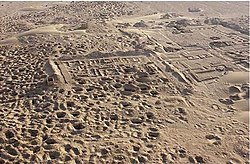Top Qs
Timeline
Chat
Perspective
Lugalannatum
Governor of Umma From Wikipedia, the free encyclopedia
Remove ads
Lugalannatum (𒈗𒀭𒈾𒁺, lu-gal-an-na-tum; fl. c. 2130 BC)[2] was a ruler ("patesi") of the city of Umma.
Tablet of Lugalannatum
Lugalannatum is known from a deposit tablet, now in the Louvre Museum, in which he mentions the rule of Si'um, king of the Gutians.[3][2] The tablet was first published in 1911, and first revealed the existence of a Gutian dynasty of Sumer.[1][4] The tablet is written in the Akkadian language following the influence of the former Kingdom of Akkad, and uses Sumerian cuneiform characters for their phonetical value.[2] It reads:
Lugal-an-na-tum/ pa-te-si/ GIS UH KI-ge/ GIS UH Kl/ ba-ba-a/ 30 + 5 mu/ sal-la-ba/ ê pa GIS UH Kl/ sal-sal/ temen-bi/ ki-a ni-si-si/ me-bi sag-ba/ si-ba-ni-sa/ ud Ba-si-û-um/ lugal Gu-ti-um kam
Lugalannatum, patesi of Umma, (as) Umma for 35 years abounded in liberalities, Ê PA, the rich temple of Umma, its foundations he established, he ensured rites inside, and set up rules, at the time of Ba-siûm, king of Gutium.
— Tablet of Lugalannatum[1]
The name of the Temple, previously thought to be "Ê PA Temple", is now understood as being "Scepter Temple", and read E.GIDRU.[2]
The text shows the allegiance of Lugalannatum, as simple Governor of Umma, towards the Gutian king of Sumer.[5]
There is also an inscription by Lugalannatum, dedicated to the life of Urgigir.[6]
- The name Lugalannatum in archaic linear script, and in standard Sumero-Akkadian cuneiform (𒈗𒀭𒈾𒁺)
- Mention of Gutium in the tablet (last column: 𒄖𒋾𒌝𒆠, gu-ti-umKI)
Remove ads
References
Wikiwand - on
Seamless Wikipedia browsing. On steroids.
Remove ads





